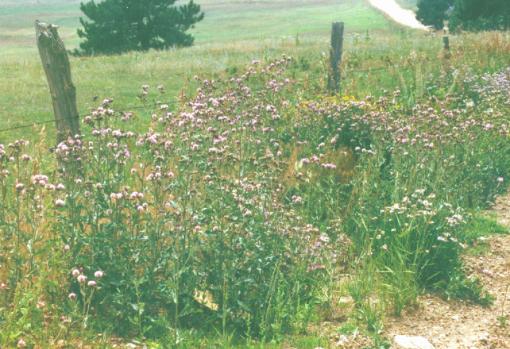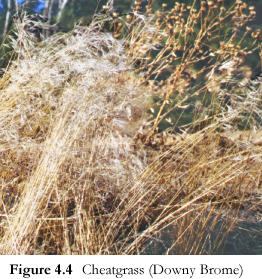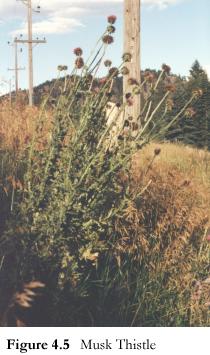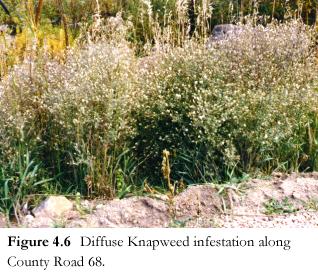


Noxious weeds are a serious problem throughout western United States, and Boulder County is no exception. Invasions of various types of these exotic (introduced) weeds can be found along Magnolia Road, along spur roads off Magnolia Road, and on private and public land in our area.
Noxious weeds are particularly tenacious once they become established. They can outcompete native plants and continue to spread rapidly if unchecked. Most of these weeds were introduced to the United States from Eurasia. Their native climate is often similar to what we have in Colorado, but because they evolved in different ecosystems, they have few if any natural enemies. Introduction into a defenseless ecosystem results in rapid colonization. Once weeds are established, seed output is usually very large and seeds frequently have great longevity.
 |
| Figure 4.3 Canada Thistle is often found along roads and other areas of soil disturbance. |
Invasive weeds outcompete crops for soil and water resources and the quality of grazing lands may be reduced dramatically. The beauty of once-pristine areas may be affected to the degree that outdoor recreation and tourism are adversely impacted. Some western states such as Idaho and Montana have had tens of thousands of acres devastated by noxious weeds.
In our country, with its tendency for large-scale movement of people and goods, it is inevitable that these weeds will spread throughout the west in a relatively short time. On a local level, seeds from weeds, such as diffuse knapweed (Acosta diffusa), that are prevalent in the plains of Boulder County can hitch a ride on cars or other equipment that travel up Magnolia Road and then fall off, usually along roadways where there is loose soil favorable for germination. Others arrive in wild flower seed mixes of dubious origin or are escaped ornamentals.
The major starting point for many noxious weeds is soil disturbance. Road grading, new home and associated road construction are the major causes of soil disturbance in the Planning Area. This activity introduces an ideal place for weed infestations to get started. Over-grazed pastures will usually be quickly invaded by noxious weeds.
Management of noxious weed infestations is dependant on a number of factors including the characteristics of each weed species, habitat, surrounding environment, and the availability of equipment, materials, and people. Control of noxious weeds can be very difficult and requires significant effort and funding for large scale programs. Early eradication, when infestations are small, will save enormous time and effort and will almost assuredly be more effective than attempts to control noxious weeds once they have become widespread. The importance of educating the public cannot be over-emphasized, especially those who frequent our public lands.
There are different types of controls such as preventative, cultural, biological, chemical, and mechanical. Preventative controls restrict indiscriminate introduction of weeds as well as restricting transportation of weeds from one place to another. Cultural control refers to crop rotation, introduction of different crops, and seeding of native species that are aggressive enough to keep weed infestations at bay. Biological controls involve the use of insects that attack specific weed species without affecting native plants. In chemical control, herbicides are used to kill weeds. Herbicides that are relatively environmentally safe and specific (i.e. attack only certain families of weed species) are preferable to more general herbicides that kill plant life indiscriminately. Finally, mechanical control ranges from mowing to cutting to hand-pulling. Research and testing of these controls is progressing at a rapid rate. But one method of control generally cannot work alone. Instead, successful long-term management of noxious weeds typically relies on a combination of preventative, cultural, biological, chemical and mechanical controls. In other words, an integrated weed management program is necessary.
Different species require different control measures. Timing is also extremely important. Control actions should be implemented when individual weed species are most vulnerable, often when flowers have formed, but before seeding.
The most important component in the fight against weeds is education. The more people become aware of the problem of noxious weeds, their identification, and eradication, the better chance we have to successfully control them.
Those noxious weeds documented in the Planning Area are displayed in Table 4.2 below. Information regarding the most widespread or challenging species follows. The complete state noxious weed list can be found in Appendix 4.6.
|
Common Name |
Scientific Name |
|
Canadian Thistle |
Cirsium arvense |
|
Common Mullein |
Verbascum thapsus |
|
Dalmatian Toadflax |
Linaria dalmatica |
|
Dames Rocket |
Hesperis matronalis |
|
Diffuse Knapweed |
Acosta diffusa |
|
Spotted Knapweed |
Acosta maculosa |
|
Downy Brome |
Bromus tectorum |
|
Leafy Spurge |
Euphorbia esula |
|
Musk Thistle |
Carduus nutans |
|
Yellow Toadflax |
Linaria vulgaris |
Canada thistle, which flowers in July and August, is a perennial and tends to form colonies with extensive deep horizontal roots. This species is found throughout the Magnolia area, particularly in moist meadows, wet ditches along roads, and areas of topsoil disturbance (Figure 4.3)
It can be particularly difficult to control because of the rhizomatous roots. Pulling up a plant breaks the roots, encouraging plant proliferation. Because of this, chemicals are often necessary for effective control, but are only effective when used consistently over a sustained period. Herbicides that break down over time are the safest alternative. (Curtail is currently recommended. It has the lowest effective toxicity, is specific for broad-leaved plants, and biodegrades quickly.) In the case of major infestations, treatments should be repeated several times each year, over a number of years. An alternate option is a program of spring and summer mowing/grazing combined with application of herbicides in the Fall.
It is important that plants be treated by late summer before flower heads go to seed. If this is not done one must cut and bag the flower heads before treatment, as the heads will continue to mature and produce seeds even after cut from the plant stem.
A biennial introduced from Asia via Europe, this plant is a wooly basal rosette its first year. It sends up a thick flower stalk in its second year, with small yellow flowers. It can spread aggressively because of the enormous numbers of seeds it produces. While it is difficult to control; we have had good local success with pulling the plant and also cutting and bagging the flowering stalks just before they go to seed ( Absolutely necessary because they will continue to mature and produce seeds even after cut from the plant stem). As with all weedy species control, this must be acknowledged as a long term project to be successful in the long run.

Cheatgrass is found in many open areas in the Magnolia area, and can often be found along roadsides (Figure 4.4). The seeds easily attach themselves to both people and animals, encouraging their spread. Cheatgrass sticks to footwear and socks, and can cause serious infections in pets when it works its way into their skin.
Cheatgrass often finds an opportunity to establish itself and maintain dominance for many years under conditions of disturbance, such as those produced by overgrazing, fire, roads, and construction activities. It is highly flammable due to its complete summer drying, and is thus a potential fire hazard. Seed can remain viable for more than two years. Though it can be useful as forage in the early spring, it completes its life cycle by early summer. Thus its usefulness as forage quickly disappears as it dries out and becomes unpalatable.
Cheatgrass can be effectively controlled, but seeding native grasses in areas taken over by cheatgrass will not succeed until the cheatgrass is eliminated. This can only be accomplished by taking advantage of its being an annual and keeping it from producing seed. It is possible to do this by regular mowing, keeping it from reaching the seed producing stage. In this way it will be unable to reproduce, giving perennial grasses the chance to re-establish themselves.
These undeniably beautiful feral snapdragons are escaped ornamentals found along roadsides and in pastures. They are deep-rooted creeping perennials which are extremely aggressive, crowding out native vegetation. Once established, they are very hard to control.
This escaped ornamental is another beautiful plant considered undesirable. A mustard, it has racemes of tiny bright magenta flowers on single stems about 2 to 3 feet tall. It has apparently been introduced on Magnolia in wild flower seed mixes.
Leafy spurge, introduced from Europe in the early 19th century, is a creeping perennial that reproduces by seed and creeping roots. The roots can extend as deep as 30 feet and are extremely wide spreading. It has been found in the Magnolia area, specifically on Stilson's Ranch on Magnolia Drive. The most serious impact of leafy spurge is the reduction of native grasses and other plants due to this weed's superior competitive abilities. Impacts include loss of food sources for grazing animals.
Control of leafy spurge requires a long term commitment. Due to the deep and hardy root system, the cost of controlling leafy spurge can be extreme. Control of the weed in the first few years of infestation can be relatively easy. But after several years the root system becomes so well developed that the plants are little affected by mechanical or herbicidal methods. Because of hybridization since its appearance into this country, introduction of its natural enemies from Europe have had inconclusive results. Although unpalatable to cattle, sheep and goats eat leafy spurge and can be useful in its control. Avoidance of overgrazing or other land disturbances is very important.
 Musk
thistle is found throughout the Planning Area, but primarily alongside roads
or other disturbed areas (Figure 4.5). Musk thistle normally requires two growing
seasons to complete its life cycle. This weed can be controlled by pulling,
but if the weed has already begun to flower the seed heads should be removed
from the plants to avoid re-seeding. Treated areas must be re-visited in order
to ensure control. Since plants in the early bloom stage don't re-sprout, cutting
the plant at the base at the proper time can also be effective, again making
sure seed heads are not mature enough to produce seeds. As with other thistles,
flower heads will continue to mature and produce seeds even after cut from the
plant stem; it is necessary to bag them.
Musk
thistle is found throughout the Planning Area, but primarily alongside roads
or other disturbed areas (Figure 4.5). Musk thistle normally requires two growing
seasons to complete its life cycle. This weed can be controlled by pulling,
but if the weed has already begun to flower the seed heads should be removed
from the plants to avoid re-seeding. Treated areas must be re-visited in order
to ensure control. Since plants in the early bloom stage don't re-sprout, cutting
the plant at the base at the proper time can also be effective, again making
sure seed heads are not mature enough to produce seeds. As with other thistles,
flower heads will continue to mature and produce seeds even after cut from the
plant stem; it is necessary to bag them.
Introduced from Eurasia as a contaminant in alfalfa and clover seed, spotted knapweed is an appalling opponent. It is a biennial or short-lived perennial with one or more stems, which can grow up to four feet tall. In Montana, this plant has become an ecological disaster. On Magnolia, it is found mixed with diffuse knapweed on the Front Range Trails and alongside some County roads. Spotted knapweed hybridizes with diffuse knapweed.
Diffuse knapweed is a many-branched annual or short-lived perennial, 1 to 3 feet tall. Reproducing only by seed, it has been found in the Magnolia area, specifically along the Front Range Trails and along County Road 68J (Figure 4.6).
 All
knapweeds, originating primarily in the Mediterranean region, are very competitive
weeds that threaten to exclude many native species. They establish themselves
readily on disturbed sites such as roadsides and dry rangeland. They are prolific
seed producers, and seeds can lie viable in the soil for years.
Flower heads will continue to mature and produce seeds even if the plant is
pulled up by the roots; it is necessary to bag them.
All
knapweeds, originating primarily in the Mediterranean region, are very competitive
weeds that threaten to exclude many native species. They establish themselves
readily on disturbed sites such as roadsides and dry rangeland. They are prolific
seed producers, and seeds can lie viable in the soil for years.
Flower heads will continue to mature and produce seeds even if the plant is
pulled up by the roots; it is necessary to bag them.
The best cultural control is keeping land in good condition with a good cover of native plants, reseeding disturbed areas, and immediate and sustained action against small infestations. Overgrazing must be avoided. Biological controls are being researched, but their effectiveness remains to be determined. Herbicides could be effective on small infestations, but are impractical once the area affected becomes excessive. It cannot be over-emphasized that to prevent knapweed from devastating the Colorado Front Range, we must act boldly against infestations while they are still small enough to control. This requires considerable education, action and the political and local will to commit the necessary resources.
 |
 |